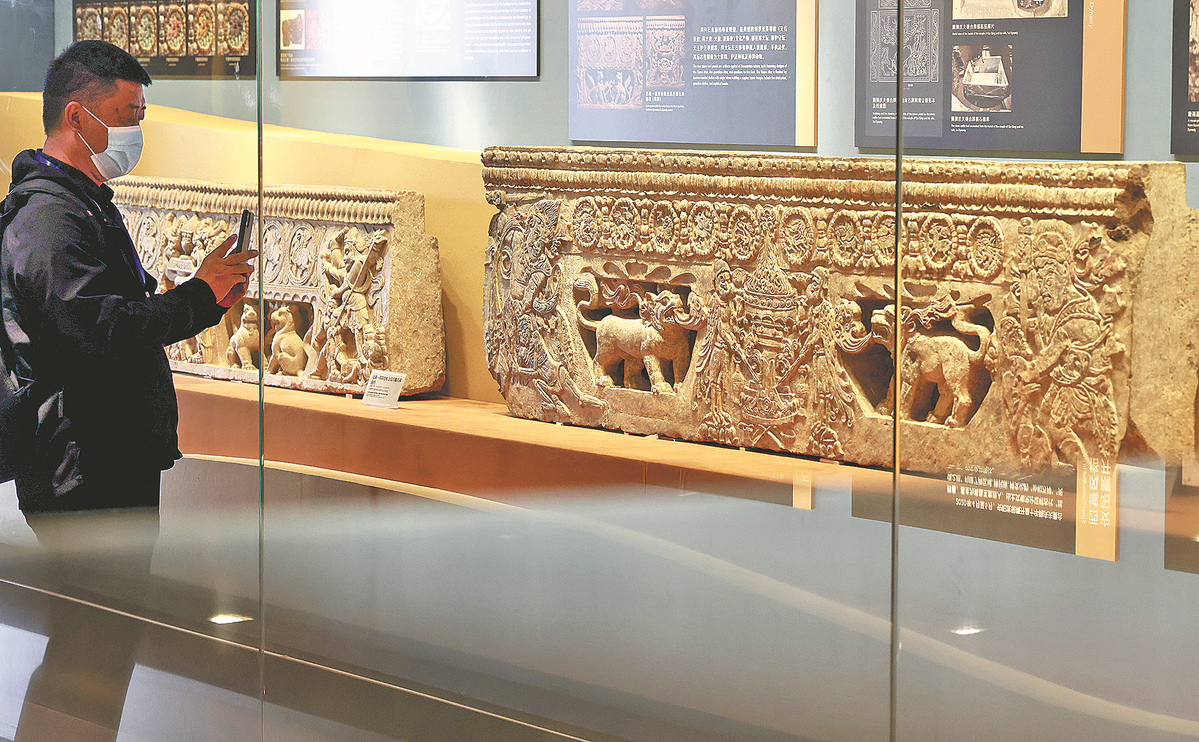By WANG KAIHAO Source:CHINA DAILY 2023-09-30

A visitor looks at panels of stone funeral beds during an exhibition at the Palace Museum in Beijing on Thursday. The panels, which feature the artistic style of the Sogdian people, who played a key role in cultural communications along the ancient Silk Road, were repatriated from the United States in MayA visitor looks at panels of stone funeral beds during an exhibition at the Palace Museum in Beijing on Thursday. The panels, which feature the artistic style of the Sogdian people, who played a key role in cultural communications along the ancient Silk Road, were repatriated from the United States in May. ZHU XINGXIN/CHINA DAILY. ZHU XINGXIN/CHINA DAILY
Fruitful achievements have been made in joint archaeology programs involving China in the past decade thanks to the Belt and Road Initiative, and the highlights of these are on display at a major exhibition in Beijing.
Thriving in a Collaborative World: "Belt and Road" Cooperation in Cultural Heritage and Archaeology, opened on Thursday in the Shenwumen (Gate of Divine Prowess) Gallery at the Palace Museum in Beijing, displaying 84 artifacts from 17 institutions from home and abroad.
According to Hu Heping, minister of culture and tourism, China has conducted 44 cooperative archaeological projects involving 24 countries in the past decade. The country also took part in 11 international historical monument conservation programs in six nations.
"Cultural heritage conservators from China and the rest of the world joined hands to safeguard the shared treasures of humanity," Hu said at the opening ceremony of the exhibition. "They've written a charming chapter of people-to-people connectivity.
"The exhibits also highlight the spirit of the Silk Road that emphasized inclusiveness, mutual learning and win-win cooperation," he added.
Many artifacts in the ongoing exhibition, which will run through January, were excavated in Sino-foreign joint archaeological programs in recent years along the land and maritime Silk Road.
Cultural heritage research institutes from countries including China, Kazakhstan, Uzbekistan and the United Arab Emirates are also presenting their key collections reflecting communication among civilizations along the ancient trade routes.
For example, the exhibits include a rubbing of a stone tablet, which was discovered by Chinese and Saudi archaeologists at Al-Serrian, the ruins of a port near Mecca, and Chinese porcelain shards were unearthed in a China-UAE joint mission at the ruins of Jurfa in the UAE.
According to Wang Guangyao, a researcher at the Palace Museum and a curator of the exhibition, the blue-and-white imperial porcelain pieces from the early Ming Dynasty (1368-1644) found in the UAE may come from one of the voyages across the Indian Ocean made by the great Chinese mariner Zheng He's fleets.
An exhibited Tang Dynasty (618-907) pottery figurine of a camel, unearthed in Xianyang, Shaanxi province, may remind people of the busy caravans along the Silk Road.
Other artifacts such as murals from a 9th-13th century Nestorian (a branch of Christianity in Syria) temple ruin in the Xinjiang Uygur autonomous region and a winged Sphinx pendant, from the second to the first century BC, excavated in Uzbekistan further point to the inclusive nature of that trade network throughout history.
Two exquisite panels of Chinese stone funeral beds, which were believed to be between the 4th and 7th century, also made their debut for public exhibition. Once lost overseas, they were repatriated from the United States in May, demonstrating close China-US cooperation in cracking cultural relic-related crimes.
At the opening ceremony of the exhibition, Saida Mirziyoyeva, presidential assistant of Uzbekistan, recalled Chinese monk Xuanzang's westward journey during the Tang Dynasty to connect China and Central Asia. She said the exhibits dating back to Xuanzang's time would inspire more economic and cultural cooperation in modern times.
Nurlan Akkoshkarov, minister counselor of the embassy of Kazakhstan to China, said, "The ancient Silk Road was not only for the movement of goods, but also for the exchange of knowledge and ideas, and the mutual enrichment of cultures."
Copyright © Xizang Daily & China Xizang News All rights reserved
Reproduction in whole or in part without permissions prohibited
Index Code: 藏 ICP 备 05000021 号
Producer: Xizang Daily International Communication Center